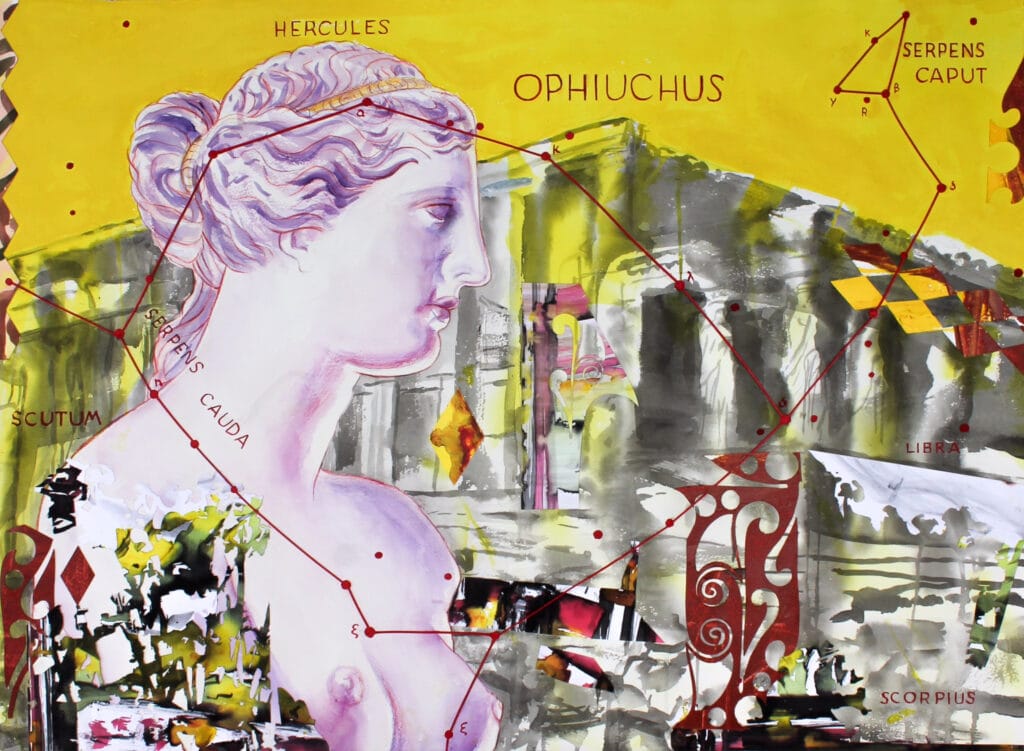Inside of the gorgeous, open space of EAD Fine Art Gallery in downtown Dayton, flowing majestically on the pristine white walls, Cynthia Kukla’s “Separating the Earth from the Heavens” gives exquisite entrances into Ancient Greece through mastered watercolor, gouache, and collage techniques. Separated by three sections and lit by the afternoon sunlight coming in from the uncovered windows, the exhibition contains framed two-dimensional renderings significantly entailing a creative scholar’s effort to celebrate a place birthing some of the world’s most beguiling legacies and mythologies.

“With these paintings, I wish to bring you back with me to Greece where I sat on random marble blocks strewn about, the magnificent surviving ruins before me,” Kukla says in her introduction of the first section. Watercolor is a supreme preference for those who aim to capture nature. An artist must be dedicated and patient, layering and layering foundations, seeing and waiting as each stroke dries to its true hue. Several plein air sketches were made in sight of the Parthenon, Philippi, Mycenae, and Delphi and stained by the additive medium of rain spilling little droplets onto Kukla’s paper. These small scale renditions reveal the value in time-invested precision, that watercolor was the best choice to tell these observational narratives. In the serene and humble “St. Nicholas Eklisaki I,” created in Olympiada, a modest brick structure almost blends into its surroundings of rock and plant life. It is a small scale work representing man’s desire to exist alongside the majestic outdoors— not dominate or overwhelm.

“The paintings in this gallery represent the distillation of ideas and images after my time in Greece,” Kukla says of the larger second section devoted to works made in studio, where daring experimentalism merges classical academia tradition with modernistic approaches. A certain radiance gives a magical air to an obsessively captured statue and texts overlaid on heavy Arches paper bearing the weight of layered materials. For example, a premiere highlight is the imaginative “Arcadia II: xx (Aphrodite’s Visions),” a powerful watercolor/gouache with handwritten words Hercules— the half-human son of Jupiter/Zeus, Ophiuchus— the “serpent-bearer” often depicted as a man wielding a snake, and Serpens Caput (serpent head) and Serpens Cauda (serpent tail) refers to the Ophiuchus constellation. The profiled aristocratic bust of Aphrodite demurely colored in a feminine blush rose situates above a Greek structure that recalls the Pantheon. Thick, opaque patterns add intriguing design below the composition in addition to cut out paper adhered to certain parts of the rich yellow surface.

“My Orstraka: Odyssey xxiii” also employs similar strategic geometric interruptions, either meticulously painted in rich blue swirls or cut gold striped spirals to heighten the drama around a one-armed statue. The moody background has a cinematic intensity, as though built to achieve the effective red coming forth from a complex brown. The pupil-less figure dressed in draping cloth centers, his stance daring with hand clenched.

Another strong piece is “My Ostraka: Odyssey xii,” a watercolor and gouache portrait explored in tender blue washes, veering into expressionistic territory. The diverse range in shapes and hues of Alexander the Great’s expressive, slightly tilted head conveys a harrowing agony or despair or perhaps an innermost longing. For an artist committed to retaining memories of these prolific travels, this work exemplifies an emotional complexity, a passionate dedication in maintaining authenticity to the subject. In that face of tonal shifts, innovation combined with demonstrated skill and desire to push beyond the simple study.

“On my third trip to work in Greece, I stayed for several weeks at Olympiada— adjacent to ancient Stagiera, birthplace of the great philosopher Aristotle,” Kukla wrote in a prelude to the final section that focuses on Alexander the Great and Aristotle. Dual pictures repeat significant faces and statues that require keen observation in order to truly appreciate her purposeful nuances. “My Ostraka: Odyssey I: iii” features two book pages of Alexander the Great— full on face and side profile— and hard-edged leaf embellishments that again act as decorative devices breaking up the monotony.
Yet, for all the technical talents and bold experiments displayed throughout the exhibition, a poetic sincerity shines in a soft, black and white “Arcadia II: xvi,” a medium-sized watercolor illustrating the sacred site at Dion, Greece. Two parallel columns seem birthed from the ground while a shorter fully clothed statue settles in between, acting as a quiet, nonthreatening mediator. Nature dominates as the more imperative character, defined in swept leaves, tall blades of grass, and colossal rock formations.
“Separating the Earth from the Heavens” far encompasses the act of seeing thirty-seven works gathered together. This show functions as a thoughtful educational experience for viewers. As a cohesive whole, Kukla presents a meaningful experience pulling us into an unforgettable history, bringing a sophisticated charm in distinctively styled drawings and paintings of precious landscapes and marble sculptures. Alongside the art, Kukla’s travel stories are just as imperative, determination stories of walking miles with art supplies and braving hot weather elements in order to make inspirational art for those who covet the ancient past or those who wish to follow an enlightening journey. Kukla has seen where Julius Caesar was betrayed, witnessed statues of goddesses Athena and Aphrodite, and stepped in the very places Aristotle and Alexander the Great once conquered minds.
Come down to Dayton and explore Cynthia Kukla’s beautiful devotion to the tiny island of Greece.
Cynthia Kukla’s “Separating the Earth from the Heavens” is up at EAD Fine Art Gallery on 222 N. St. Clair St. until July 15, 2023 with a closing reception held on its last day from 2PM-4PM.